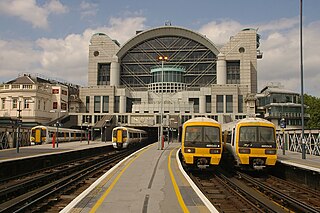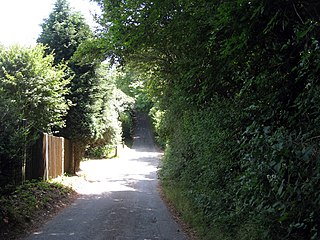
Thameslink is a mainline route on the British railway network, running from Bedford, Luton, St Albans City, Peterborough, Welwyn Garden City, London Blackfriars and Cambridge via central London to Sutton, Orpington, Sevenoaks, Rainham, Horsham, Three Bridges, Brighton and East Grinstead. The network opened as a through service in 1988, with severe overcrowding by 1998, carrying more than 28,000 passengers in the morning peak. All the services are currently operated by Govia Thameslink Railway. Parts of the network, from Bedford to Three Bridges, run 24 hours a day, except on early Sunday mornings and during maintenance periods.

The Northern line is a London Underground line that runs between North London and South London. It is printed in black on the Tube map. It carries more passengers per year than any other Underground line – around 340 million in 2019 – making it the busiest tube line in London. The Northern line is unique on the Underground network in having two different routes through central London, two southern branches and two northern branches. Despite its name, it does not serve the northernmost stations on the Underground, though it does serve the southernmost station at Morden, the terminus of one of the two southern branches.

Biggin Hill is a town in the London Borough of Bromley, about 15.2 miles (24.5 km) south-southeast of Charing Cross. It is separated from London's built-up area by the Metropolitan green belt and is located adjacent to the Greater London boundary with Kent and Surrey. Prior to the creation of Greater London in 1965, it was part of Kent. At the 2011 Census, Biggin Hill had a population of 9,951.

Herne Hill railway station is in the London Borough of Lambeth, South London, England, on the boundary between London fare zones 2 and 3. Train services are provided by Thameslink to London Blackfriars, Farringdon, St Pancras International and St Albans on the Thameslink route and by Southeastern to London Victoria and Orpington on the Chatham Main Line. It is 3 miles 76 chains (6.4 km) down the line from Victoria.

Downe, formerly Down, is a village in Greater London, England, located within the London Borough of Bromley, which formed part of the historical county of Kent until 1965, and is beyond London's contiguous urban area. Charles Darwin lived in Down House for forty years until his death in 1882.

Warlingham is a village and civil parish in the Tandridge district of Surrey, England, 14 miles (23 km) south of London and 22 miles (35 km) east of Guildford. Warlingham is the centre of a civil parish that includes Hamsey Green to the north. Caterham is 2 miles (3.2 km) to the southwest.

Orpington railway station is on the South Eastern Main Line, serving the town of Orpington in the London Borough of Bromley, south-east London. It is 13 miles 65 chains (22.2 km) down the line from London Charing Cross and is situated between Petts Wood and Chelsfield stations. It is in Travelcard Zone 6.
Colonel Holman Fred Stephens was a British light railway civil engineer and manager. He was engaged in engineering and building, and later managing, 16 light railways in England and Wales.

The Oxted line is a railway line in southern England. It runs from the Brighton Main Line at South Croydon in Greater London to Hurst Green Junction in Surrey, where its two branches diverge. The western branch continues via Lingfield to East Grinstead in West Sussex, whereas the eastern branch runs via Edenbridge Town in Kent to Uckfield in East Sussex. The line is named after the town of Oxted in Surrey and also serves parts of the London Borough of Croydon. The 18-mile-26-chain (29.5 km) South Croydon–East Grinstead section is electrified using the 750 V DC third-rail system and is double track throughout. The unelectrified Hurst Green Junction–Uckfield section is 24 mi 53 ch (39.7 km) in length and, south of Hever, is mostly single track.

Sanderstead railway station is on the Oxted Line in the London Borough of Croydon, 1 mile (1.6 km) from Sanderstead village. It is in Travelcard Zone 6, 12 miles 23 chains from London Bridge. The station is managed by Southern.

The Woodside and South Croydon Joint Railway (W&SC) was a short, relatively short-lived and unsuccessful railway in the London Borough of Croydon in London, England. Its site is now largely occupied by Tramlink.

Sutton railway station (sometimes referred to as Sutton (Surrey) on tickets and timetables) is in the London Borough of Sutton in South London and is the main station serving the town of Sutton. It is served by Southern and Thameslink trains, and lies in Travelcard Zone 5, 14 miles 75 chains (14.94 miles, 24.04 km) down the line from London Bridge, measured via Forest Hill.

The South Eastern Main Line is a major long-distance railway route in South East England, UK, one of the three main routes crossing the county of Kent, going via Sevenoaks, Tonbridge, Ashford and Folkestone to Dover. The other routes are the Chatham Main Line which runs along the north Kent coast to Ramsgate or Dover via Chatham and High Speed 1 which runs through the centre of Kent to the coast at Folkestone where it joins the Channel Tunnel.

Tatsfield is a village and civil parish in the Tandridge District of Surrey, England. It is located 3.3 miles north west of Westerham and 3.9 miles north east of Oxted, and is adjacent to the Surrey border with both Greater London and Kent.
The Cairn Valley Light Railway was a rural railway line built to connect Moniaive and other communities in the Cairn Valley with the main railway network at Dumfries. It opened in 1905 but usage was disappointing, and declined further when bus companies started competing. It was closed to passengers in 1943, and completely closed in 1949.

Chelsfield is an area in southeast London, England, within the London Borough of Bromley and, prior to 1965, in the historic county of Kent. It lies south of Goddington, west of Well Hill, north of Pratt's Bottom and east of Green Street Green. The area is split into two distinct areas – the historic 'village' section, and the newer development by the railway station.
Transportation needs within the county of Kent in South East England has been served by both historical and current transport systems.
The Amesbury and Military Camp Light Railway was a branch line in Wiltshire, England, constructed under a light railway order, the Amesbury and Military Camp Light Railway Order 1898, dated 24 September 1898. It was opened for military traffic from Amesbury to the east-facing Newton Tony Junction on 1 October 1901. A west-facing junction, Amesbury Junction, where the branch burrowed under the main line, opened on 2 June 1902. The line closed in 1963.

Berry's Green a small hamlet in the London Borough of Bromley in Greater London, UK, situated outside of London's contiguous built-up area. It is a fairly wooded rural area with a scattering of farmland. Housing consists mainly of detached properties, mostly bungalows, with a row of local authority cottages and a static mobile home site. It is part of the largest ward in Greater London, Darwin (ward). When the Ward was first constituted in 1965, Berry's Green, was joined with Downe, Cudham, Leaves Green, Single Street, Luxted, and Westerham Hill. The current elected political party's website (2022), states the present named other areas as Downe, Cudham, Leaves Green, Leavesden Estate, Westerham Hill, Beechwood, and Pratts Bottom

Coombe Road was a railway station on the Woodside and South Croydon Joint Railway in London. When it was closed it was owned and managed by British Rail.
















